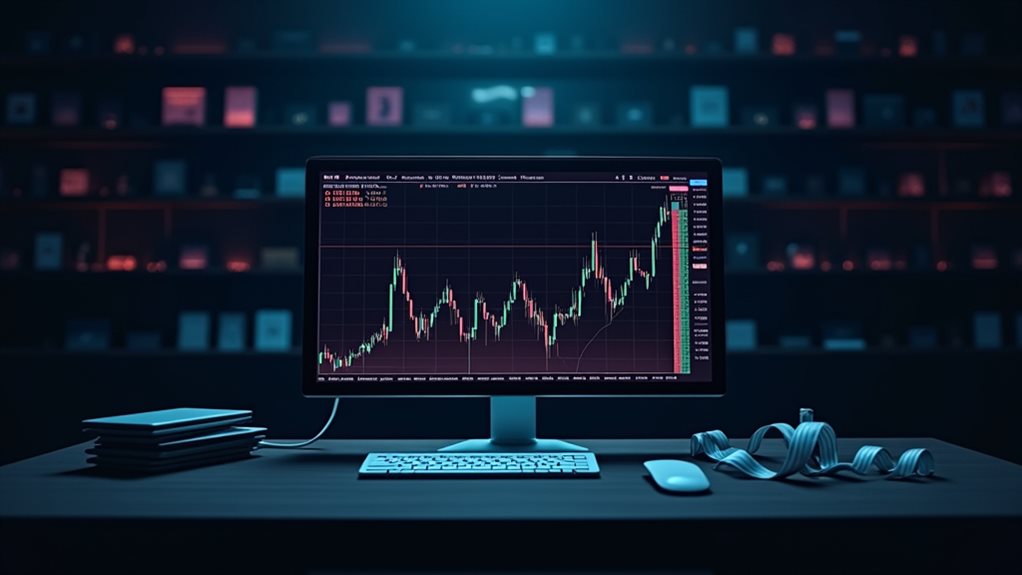Buying crypto during a crash isn’t for the faint of heart – it’s like trying to catch a caffeinated squirrel. While major cryptocurrencies often bounce back from crashes, you’re facing serious risks of further drops and liquidity challenges. Historical data shows markets can plummet over 70% from their highs. Smart investors use dollar-cost averaging and stick to well-known assets during downturns. Your best defense? Understanding the complex factors that drive crypto markets before making any moves.
Understanding Cryptocurrency Market Crashes

While crypto enthusiasts love to brag about their gains, they’re oddly quiet when markets tank.
That’s because cryptocurrency crashes aren’t your typical market dips – they’re wild, unpredictable beasts driven by complex market dynamics and erratic investor behavior.
Here’s the reality: crypto markets run on sentiment and speculation. One minute you’re riding high, the next you’re watching prices plummet because someone tweeted something spooky.
When fear kicks in, it’s like a domino effect. Panic selling. Mass hysteria. Everyone rushing for the exits at once. The herd mentality drives massive waves of simultaneous selling.
With the Fear Greed Index dropping to 25, investor anxiety has reached concerning levels.
Think of it as a high-stakes game of musical chairs. Regulatory news, economic uncertainty, or even a single security breach can send prices tumbling. The lack of investor familiarity with cryptocurrency technology often amplifies these market fears.
And those whales? They’re not helping. Large holders can manipulate prices faster than you can say “HODL.”
Signs That Indicate a Crypto Market Bottom

Just because crypto prices are falling doesn’t mean they’ve hit rock bottom. But when they do, you’ll want to spot it. Market sentiment shifts provide vital clues – like when bad news stops tanking prices. Experienced traders look for increased trading volume to confirm potential market bottoms.
Technical indicators and on-chain metrics paint a clearer picture. The Williams Vix Fix indicator shows that high volatility bars often mark market bottoms. Using hardware wallets can protect your assets during volatile market conditions.
Here’s what typically signals we’re scraping the bottom:
- RSI diving below 30 while stakeholder accumulation rises (yeah, the whales are getting hungry)
- Social media reaching peak doom-and-gloom (when your neighbor stops bragging about crypto)
- Negative funding rates persisting in futures markets (short sellers are getting cocky)
- Price trendlines hitting historical support levels while MACD shows bullish crossovers
Let’s face it – timing the exact bottom is impossible. But these signals can help you recognize when the worst might be over.
Key Risks of Buying During Market Downturns

Spotting market bottoms is one thing – managing the serious risks of buying during crashes is another ball game entirely.
Let’s be real: market volatility can take your portfolio on a rollercoaster ride straight to zero. Those “bargain” prices? They can keep dropping. Just like bear market losses typically reach 31.7%, the crypto market can be even more severe. Fun times.
You’re facing some nasty liquidity challenges too. When everyone’s rushing for the exits, good luck selling without taking a massive hit. The reality that cryptocurrencies dropped over 70% from highs in 2022 shows just how severe these downturns can be. Experts recommend keeping no more than 10% of your portfolio in high-risk crypto investments.
And don’t get me started on emotional decision making – panic selling and FOMO buying are portfolio killers. Classic human nature at its finest.
Then there’s the regulatory implications hanging over crypto like a dark cloud. One government announcement, and poof – your investments could face new restrictions or worse.
Market manipulation? It’s everywhere, with whales playing ping-pong with your emotions and wallet.
Strategic Approaches to Crypto Investing in Bear Markets

Although bear markets feel like financial quicksand, there’s a method to the madness when it comes to strategic crypto investing. Smart investors don’t just throw money at falling prices – they’ve got a game plan. Focusing on well-known assets offers better stability during market turmoil. When investor confidence dips, these blue chip assets tend to show more resilience.
The emergence of stablecoin adoption has created new opportunities for managing risk during market volatility.
DCA benefits shine during market downturns, letting you scoop up more crypto when prices tank. Dip purchasing? Yeah, it’s a thing. But timing isn’t everything.
Here’s what seasoned crypto investors consider during bear markets:
- Diversification strategies spread risk across different crypto assets
- DCA keeps emotions in check while averaging out purchase prices
- Hedging methods protect against further downside (if you know what you’re doing)
- Dip purchasing opportunities emerge when others panic-sell
Remember: Bear markets aren’t just about survival. They’re opportunities in disguise – if you’ve got the stomach for it. Just don’t bet the farm.
Essential Research Methods Before Making Purchase Decisions

Having a game plan for bear markets is one thing – but knowing how to research before you pull the trigger?
Your investment research needs to get real. Like, actually real. Start with cold, hard data from academic sources – not just your buddy’s hot crypto tips. The evaluation of cryptocurrencies requires analyzing sixteen key factors for making informed investment decisions. The global market shows extreme price volatility, with values capable of changing dramatically within hours.
Market analysis isn’t just about price charts. You’ve got to explore the tech viability, market cap, and liquidity. Yeah, boring stuff. With Bitcoin’s historical returns of 35,224.96% over the past decade, proper analysis becomes even more critical.
Here’s the kicker: your emotions are probably messing with you more than you think. FoMO’s a beast, and herding behavior’s real. When everyone’s panic-selling, your brain’s screaming “sell!” When they’re buying like crazy, you’re itching to jump in.
Smart investors cross-reference everything. Market reports, peer-reviewed studies, expert forecasts. No shortcuts. No exceptions.
Building a Resilient Crypto Investment Portfolio

While everyone’s chasing the next crypto moonshot, building a bulletproof portfolio takes more than just YOLOing into random coins.
Smart risk diversification and strategic asset allocation can help you weather those gut-wrenching market crashes.
A solid crypto portfolio isn’t rocket science, but it does require some planning. Understanding your personal risk threshold is crucial for making informed investment decisions that align with your goals.
Passive income opportunities through staking and yield farming add another layer of portfolio diversification.
Let’s face it – the crypto market’s about as stable as a caffeinated squirrel.
During major market downturns, Bitcoin’s dominance tends to influence altcoin performance significantly.
Here’s what battle-tested portfolios typically include:
- Mix of large-cap cryptos (yeah, Bitcoin and Ethereum) with some calculated alt-coin plays
- Stablecoins for those “oh crap” market moments
- Regular rebalancing schedule (because letting winners run forever is asking for trouble)
- Different asset classes spread across the crypto ecosystem
Remember: even the most resilient portfolio can’t completely escape crypto’s wild mood swings.
That’s just part of the game.
Psychological Aspects of Trading During Market Crashes

Building a solid portfolio is one thing – keeping your cool when the market tanks is another beast entirely.
Let’s be real: fear-driven decisions during crypto crashes rarely end well. You’re not alone if your brain goes into full panic mode when prices plummet.
Here’s what’s happening in your head: Loss aversion kicks in (because losing hurts way more than winning feels good), and suddenly you’re part of a herd racing for the exits. The overwhelming irrational exuberance that drove prices up can quickly turn to panic on the way down.
Algorithms and trading bots don’t help either – they’re busy amplifying the chaos while your emotional resilience gets put through the wringer.
Technology makes everything move faster, which means your stress levels shoot through the roof. Those quick price swings? They’re testing your sanity. Recent multi-billion liquidations have shown just how quickly markets can turn against investors.
And just when you think you’ve got it figured out, confirmation bias tricks you into seeing only what you want to see.
Using a stop-loss order can help remove emotion from your selling decisions and protect your investment during market downturns.
Timing Strategies for Crypto Market Entry Points

When’s the right time to plunge into a crypto crash?
Let’s face it – timing techniques aren’t rocket science, but they’re not exactly a walk in the park either.
Smart entry strategies during market mayhem boil down to a few key approaches.
- Dollar-cost averaging (DCA) – because nobody’s got a crystal ball for perfect timing
- Setting buy orders at predetermined technical support levels – yeah, those squiggly lines matter
- Maintaining a stablecoin reserve to pounce on sudden dips – be ready when opportunity knocks
- Using a phased entry approach aligned with your predefined plan – don’t blow your whole stack at once
With trading volume down 54% since December, patience and strategic planning are more crucial than ever.
Cultivating emotional discipline helps you stick to your strategy when markets get turbulent.
Remember to stay focused on your investment strategy and avoid letting FOMO or FUD influence your buying decisions during market volatility.
Long-Term Growth Potential in Bearish Conditions

Despite what your gut might tell you during a crypto bloodbath, market crashes pack some serious long-term potential. Historical recovery patterns show that major cryptocurrencies often bounce back – and then some.
Look at Bitcoin’s COVID-19 crash: down 50%, then boom – new all-time highs within months. After the March 2020 drop to $6,206, Bitcoin reached record peaks above $64,000 by April 2021.
Here’s the thing about bearish conditions: they’re temporary. Data shows that investment strategies like “buying the dip” have worked time and time again. Not because of magic, but because leading cryptocurrencies tend to surpass their previous highs over multi-year periods. According to analyst Michael van de Poppe, we can expect a market recovery following the current uncertainty.
With Bitcoin’s surge of 145% in 2024 and strong support levels at $70,000, the foundation for sustained growth appears solid.
Even after brutal corrections. Even after exchange collapses.
Sure, timing isn’t everything. The real story lies in long-term fundamentals and adoption.
Markets recover. They always have. Sometimes quickly, sometimes slowly – but they recover.
Frequently Asked Questions
How Do Crypto Taxes Work When Buying During Market Crashes?
You won’t face immediate tax implications when buying crypto during crashes, but you’ll need to track purchase prices for future reporting requirements. Tax events occur only when you sell, trade, or use cryptocurrency later.
Can I Use Retirement Accounts Like IRAS to Invest in Cryptocurrencies?
Yes, you can invest in crypto through self-directed IRAs with qualified custodians. Your retirement account options include transferring funds from traditional IRAs to crypto-friendly custodians, but you’ll need to follow specific IRS regulations.
What Happens to Staked Crypto if an Exchange Fails During Crashes?
You’ll likely lose access to your staked assets if an exchange fails, as they become entangled in bankruptcy proceedings. Even with exchange security measures, recovery can be difficult and time-consuming during these situations.
Should I Keep My Crypto on Exchanges or in Hardware Wallets?
For better security, you’ll want to store most of your crypto in a hardware wallet. Keep only what you actively trade on exchanges. This balances wallet options for protection with exchange access for transactions.
How Do Margin Calls Work When Trading Crypto During Market Downturns?
When you’re margin trading crypto, your positions face automatic liquidation if market downturns drop your collateral below required levels. You’ll need quick risk management decisions: either add funds or close positions to avoid losses.









